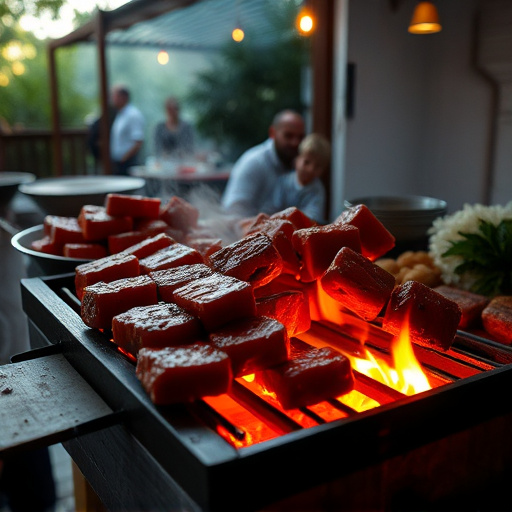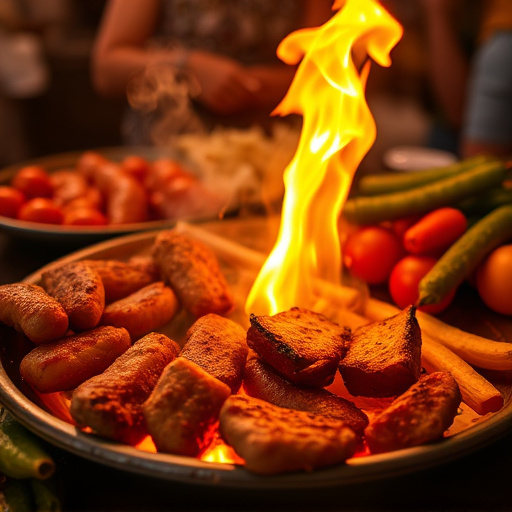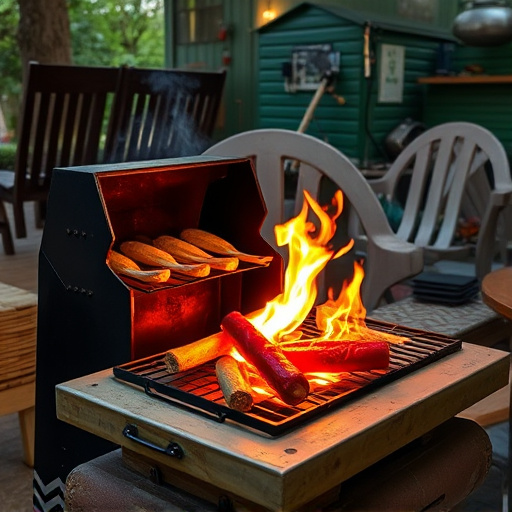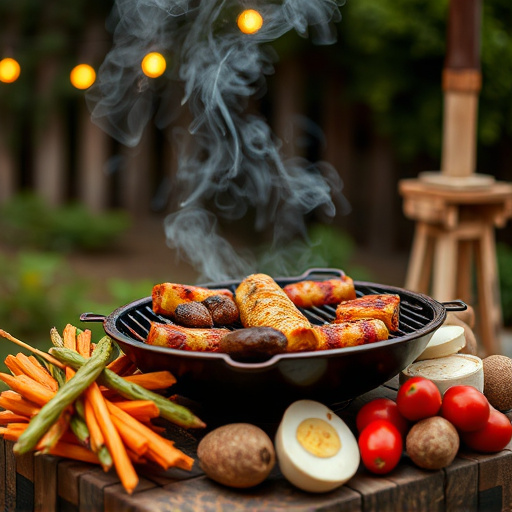Selecting the right cut of meat is crucial for a perfect BBQ beef recipe, with brisket, ribeye, and chuck steak offering unique characteristics suitable for grilling, smoking, or slow-cooking. Marination, especially with mustard, enhances tenderness and flavor. Smoking, whether direct or indirect heat, adds layers of taste and texture, with timing vital to prevent burning. These techniques cater to diverse preferences, making BBQ beef a culinary delight.
Unleash the ultimate summer sensation with this mouthwatering BBQ beef recipe, featuring a tantalizing twist of mustard! From choosing the perfect cut of meat to mastering the art of smoking and crafting delicious marinades, we’ll guide you through every step. Learn about ideal cuts like brisket, ribeye, or chuck steak, then delve into marinating techniques using a basic mustard recipe for enhanced flavor. Discover various smoking methods and estimated times, plus creative ways to incorporate mustard into your BBQ experience with unique sauce pairings and serving suggestions for a memorable meal.
- Choosing the Right Cut of Beef for BBQ
- – Discuss ideal cuts for BBQ beef, like brisket, ribeye, or chuck steak.
- Marinating the Meat: A Key Step for Flavor
- – Explain the importance of marination and provide a basic recipe using mustard.
- The Art of Smoking: Techniques and Times
- – Detail different smoking methods (e.g., direct vs indirect heat) and estimated times for various cuts.
Choosing the Right Cut of Beef for BBQ

When crafting a mouthwatering BBQ beef recipe, selecting the perfect cut of meat is the first step to success. Opting for the right cut ensures your BBQ beef turns out tender, juicy, and packed with flavor. For a classic BBQ experience, choose cuts like brisket or ribeye. Brisket, known for its rich marbling and ample fat content, smokes beautifully and remains moist during the slow cooking process. Ribeye, on the other hand, offers incredible tenderness and a robust beefy taste when grilled to perfection. Both cuts allow for a balanced combination of flavor and texture that defines an exceptional BBQ beef recipe.
Consider the varying cooking methods too—grilling, smoking, or slow-cooking—as these influence which cut is best. For direct heat grilling, thinner cuts like sirloin or flank steak can be ideal due to their quicker cook time. For low-and-slow smoking or braising, thicker cuts with more fat are preferable as they retain moisture and develop deep flavors. Understanding the characteristics of different beef cuts empowers you to create a truly remarkable BBQ beef recipe that caters to your preferred cooking style.
– Discuss ideal cuts for BBQ beef, like brisket, ribeye, or chuck steak.

When it comes to BBQ beef recipes, choosing the right cut is essential for achieving that mouthwatering, tender texture and rich flavor. For a classic BBQ experience, brisket is a top choice. Its dense nature ensures slow cooking, allowing the marbles of fat to melt and baste the meat throughout, resulting in a juicy, flavorful piece of meat. Ribeye steak is another favorite among BBQ enthusiasts due to its beautiful marbling and robust beefy flavor. The thicker cuts provide a slower cook time, perfect for enhancing the smoky taste from your BBQ grill. Chuck steak, known for its affordability and versatility, can also be excellent when prepared correctly. Look for well-marbled chunks or blades of chuck for best results, as these cuts benefit from long, slow cooking methods to break down tough connective tissues.
Marinating the Meat: A Key Step for Flavor

Marinating the meat is a crucial step in creating an exceptional BBQ beef recipe. It involves submerging the steak or brisket in a flavorful mixture, allowing the spices and sauces to penetrate and enhance its natural taste. This process can transform a simple piece of meat into a mouthwatering culinary delight. The key is to use a combination of acidic ingredients (like vinegar or lemon juice) and aromatic substances (such as garlic, onions, and herbs) that break down the meat’s fibers over time, making it tenderer and infusing it with deep, savory flavors.
For BBQ beef, a simple yet effective marinade can include mustard—a subtle yet tangy ingredient that adds complexity without overpowering the natural beef flavor. Combining mustard with oils, vinegar, salt, pepper, and various herbs creates a tantalizing mixture that will transform your steak or brisket into a juicy, flavorful masterpiece ready for the grill.
– Explain the importance of marination and provide a basic recipe using mustard.

Marination is an essential step in crafting the perfect BBQ beef recipe, as it tenderizes the meat and infuses it with mouthwatering flavors. This process involves submerging the beef in a flavorful liquid for an extended period, allowing the acids and oils to break down the muscle fibers and create a truly spectacular dining experience.
For a quick and effective marinade, combine 1/4 cup of whole grain mustard, 1/2 cup of olive oil, 2 tablespoons of honey, 1 tablespoon of soy sauce, 1 clove of minced garlic, and a pinch of salt and pepper in a bowl. This basic recipe offers a delightful balance of tanginess from the mustard, richness from the olive oil, and sweetness from the honey. Rub the marinade onto your beef chunks or slices, ensuring every piece is well-coated. Let it sit for at least 30 minutes, but for optimal results, consider marinating it in the fridge for a few hours or even overnight before grilling.
The Art of Smoking: Techniques and Times

The art of smoking is a crucial aspect of crafting that perfect BBQ beef recipe, where time and technique intertwine to create layers of flavor. The process involves slowly cooking meat at low temperatures using smoke, allowing it to penetrate and transform the beef’s taste and texture. One popular method is cold-smoking, which starts at lower temperatures (around 225°F/107°C) for an extended period, often up to 8–12 hours. This slow cookery tenderizes the meat and infuses it with a subtle smoky aroma.
For a mouthwatering BBQ beef recipe, timing is key. The smoke should be gentle, allowing the mustard-infused beef to cook evenly without burning. As the beef absorbs the smoke, its natural juices are released, creating a rich and juicy texture. This meticulous approach ensures that the final dish not only tastes delicious but also showcases the craftsmanship behind it, making it a true culinary masterpiece.
– Detail different smoking methods (e.g., direct vs indirect heat) and estimated times for various cuts.

When it comes to smoking BBQ beef, understanding different methods and their impact on various cuts is key to achieving mouthwatering results. BBQ beef recipe enthusiasts often opt for two primary approaches: direct and indirect heat. Direct heat involves cooking the meat directly over a high flame, which is ideal for thicker cuts like ribs or brisket. This method sears the exterior quickly while slowly cooking the interior, resulting in tender, smoky flavors. Times can vary, but expect to smoke brisket at around 250°F (121°C) for approximately 1-1.5 hours per pound.
Indirect heat, on the other hand, uses a closed smoker with hot coals or wood chips on one side and the meat placed on the other. This method is perfect for leaner cuts like sirloin or flank steak, allowing them to cook slowly and evenly without burning. Temperatures typically range between 225°F-300°F (107°C-149°C), and cooking times can span from 1-3 hours, depending on the cut and desired doneness. This gentle approach ensures the beef stays juicy and tender while infusing it with subtle smoky aromas, making your BBQ beef recipe a real crowd-pleaser.
